Audio-Tactile Rendering: A Review on Technology and Methods to Convey Musical Information through the Sense of Touch
Abstract
:1. Introduction
1.1. Vibrotactile Feedback
1.2. Musical Haptics
1.3. Structure of the Review
2. Methodology
2.1. Previous Reviews
2.2. Review Method
- Musical haptics;
- Haptic music;
- Haptic music player;
- Musical haptic wearables;
- Vibrotactile music;
- Vibrotactile composition;
- Vibrotactile music composition;
- Vibrotactile music player;
- Skin music;
- Skin music player;
- Music sensory substitution system.
3. Haptic Music Player (HMP)
3.1. Architecture
3.2. Actuators
3.2.1. Voice Coil Actuator (VCA)
3.2.2. Linear Resonant Actuator (LRA)
3.2.3. Eccentric Rotating Mass (ERM)
3.2.4. Piezoelectric Actuator
3.2.5. Dual Mode Actuator (DMA)
3.2.6. Loudspeakers
3.2.7. Actuator Selection
3.3. Actuator Attachment Mechanism
3.3.1. Haptic Music Player-Installation (HMP-I)
3.3.2. Haptic Music Player-Wearable Device (HMP-WD)
3.3.3. Haptic Music Player-Hybrid (HMP-H)
4. Audio-Tactile Rendering
4.1. Tactile Rendering of Rhythm
4.2. Tactile Rendering of Pitch
4.3. Tactile Rendering of Melody
4.4. Tactile Rendering of Timbre
4.5. Tactile Rendering of Loudness
5. Vibrotactile Music Composition (VMC)
5.1. Tactile Illusions
5.2. Real-Time VMC
5.3. VMC from Scratch
6. Discussion and Conclusions
Funding
Conflicts of Interest
Abbreviations
| P | Pacinian |
| NP-I | Non-Pacinian I |
| NP-II | Non-Pacinian II |
| NP-III | Non-Pacinian III |
| FAF-I | Fast Afferent I |
| FAF-II | Fast Afferent II |
| ISOA | Inter-Stimulus Onset Asynchrony |
| ATR | Audio-Tactile Rendering |
| HCHI | Human–Computer Haptic Interface |
| SSS | Sensory Substitution System |
| DMI | Digital Musical Instrument |
| HAID | Haptic and Audio Interaction Design |
| HCI | Human Computer Interaction |
| HMP | Haptic Music Player |
| DAC | Digital to Analog Converter |
| VCA | Voice Coil Actuator |
| LRA | Linear Resonant Actuator |
| ERM | Eccentric Rotating Mass |
| DMA | Dual Mode Actuator |
| VMC | Vibrotactile Music Composition |
| HMP-I | Haptic Music Player - Installation |
| BRTF | Body Related Transfer Function |
| HRTF | Head Related Transfer Function |
| ATFS | Audio-Tactile Frequency Synchronism |
| FM | Frequency Model |
| TM | Track Model |
| VMLE | Vibrotactile Music with/without Listening Experience |
| ATFM | Audio-Tactile Frequency Matching |
| F-EQ | Frequency Equalization |
| MC | Melodic Consonace |
| HMP-WD | Haptic Music Player - Wearable Device |
| MHWA | Musical Haptic Wearables for Audiences |
| VR | Virtual Reality |
| AR | Augmented Reality |
| PWM | Pulse-Width Modulation |
| FD | Frequency Discrimination |
| API | Audience-Performer Interaction |
| EEG | Electroencephalogram |
| VMID | Vibrotactile Music Input Devices |
| JND | Just Noticeable Difference |
| MIDI | Musical Instrument Digital Interface |
References
- Schneider, A.; Feussner, H. Mechatronic Support Systems and Robots. In Biomedical Engineering in Gastrointestinal Surgery; Academic Press: Cambridge, MA, USA, 2017; pp. 387–441. [Google Scholar] [CrossRef]
- Birnbaum, D.M.; Wanderley, M.M. A Systematic Approach to Musical Vibrotactile Feedback. In Proceedings of the International Computer Music Conference, Copenhagen, Denmark, 27–31 August 2007; pp. 397–404. [Google Scholar]
- Giordano, M.; Wanderley, M.M. Perceptual and Technological Issues in the Design of Vibrotactile-Augmented Interfaces for Music Technology and Media. In Proceedings of the International Workshop on Haptic and Audio Interaction Design, Daejeon, Korea, 18–19 April 2013; pp. 89–98. [Google Scholar]
- Verrillo, R.T. Vibration Sensation in Humans. Music Percept. 1992, 9, 281–302. [Google Scholar] [CrossRef]
- Chafe, C. Tactile Audio Feedback. In Proceedings of the 19th International Computer Music Conference (ICMC 1993), Tokyo, Japan, 10–15 September 1993; pp. 76–79. [Google Scholar]
- Young, G.W.; Murphy, D.; Weeter, J. Vibrotactile Discrimination of Pure and Complex Waveforms. In Proceedings of the 12th International Conference in Sound and Music Computing, Maynooth, Ireland, 30 July–1 August 2015; pp. 359–362. [Google Scholar]
- Jones, L.A.; Sarter, N.B. Tactile Displays: Guidance for Their Design and Application. Hum. Factors 2008, 50, 90–111. [Google Scholar] [CrossRef]
- Petry, B.; Huber, J.; Nanayakkara, S. Scaffolding the Music Listening and Music Making Experience for the Deaf. In Cognitive Science and Technology; Springer: Singapore, 2018; pp. 23–48. [Google Scholar] [CrossRef]
- Mirzaei, M.; Kan, P.; Kaufmann, H. EarVR: Using Ear Haptics in Virtual Reality for Deaf and Hard-of-Hearing People. IEEE Trans. Vis. Comput. Graph. 2020, 26, 2084–2093. [Google Scholar] [CrossRef] [PubMed]
- Goldstein, E.B. Sensation and Perception, 8th ed.; Cengage: Boston, MA, USA, 2010; p. 492. [Google Scholar]
- Abraira, V.E.; Ginty, D.D. The Sensory Neurons of Touch. Neuron 2013, 79, 618–639. [Google Scholar] [CrossRef] [PubMed] [Green Version]
- McGlone, F.; Wessberg, J.; Olausson, H. Discriminative and Affective Touch: Sensing and Feeling. Neuron 2014, 82, 737–755. [Google Scholar] [CrossRef] [Green Version]
- Hayes, L. Vibrotactile Feedback-Assisted Performance. In Proceedings of the 2011 Conference on New Interfaces for Musical Expression, NIME, Oslo, Norway, 30 May–1 June 2011. [Google Scholar]
- Karam, M.; Russo, F.; Fels, D. Designing the Model Human Cochlea: An Ambient Crossmodal Audio-Tactile Display. IEEE Trans. Haptics 2009, 2, 160–169. [Google Scholar] [CrossRef]
- Gunther, E.; O’Modhrain, S. Cutaneous Grooves: Composing for the Sense of Touch. J. New Music Res. 2003, 32, 369–381. [Google Scholar] [CrossRef] [Green Version]
- Chang, A.; O’Sullivan, C. An Audio-Haptic Aesthetic Framework Influenced by Visual Theory. In Proceedings of the International Workshop on Haptic and Audio Interaction Design HAID 2008, Jyväskylä, Finland, 15–16 September 2008; pp. 70–80. [Google Scholar] [CrossRef] [Green Version]
- Giordano, M.; Wanderley, M.M. A Learning Interface for Novice Guitar Players Using Vibrotactile Stimulation. In Proceedings of the 8th Sound and Music Computing Conference (SMC2011), Padova, Italy, 6–9 July 2011. [Google Scholar] [CrossRef]
- Petry, B.; Illandara, T.; Nanayakkara, S. MuSS-bits: Sensor-Display Blocks for Deaf People to Explore Musical Sounds. In Proceedings of the 28th Australian Conference on Computer-Human Interaction-OzCHI ’16, Tasmania, Australia, 29 November–2 December 2016; ACM Press: New York, New York, USA, 2016; pp. 72–80. [Google Scholar] [CrossRef]
- Petry, B.; Illandara, T.; Elvitigala, D.S.; Nanayakkara, S. Supporting Rhythm Activities of Deaf Children using Music-Sensory-Substitution Systems. In Proceedings of the 2018 CHI Conference on Human Factors in Computing Systems, Montreal, QC, Canada, 21–26 April 2018; pp. 1–10. [Google Scholar] [CrossRef]
- Musical Haptics; Papetti, S.; Saitis, C. (Eds.) Springer Series on Touch and Haptic Systems; Springer International Publishing AG: Cham, Switzerland, 2018. [Google Scholar] [CrossRef] [Green Version]
- Turchet, L.; West, T.; Wanderley, M.M. Touching the Audience: Musical Haptic Wearables for Augmented and Participatory Live Music Performances. Pers. Ubiquitous Comput. 2020, 25, 749–769. [Google Scholar] [CrossRef]
- Eitan, Z.; Rothschild, I. How Music Touches: Musical Parameters and Listeners’ Audio-Tactile Metaphorical Mappings. Psychol. Music. 2011, 39, 449–467. [Google Scholar] [CrossRef]
- Romagnoli, M.; Fontana, F.; Sarkar, R. Vibrotactile Recognition by Western and Indian Population Groups of Traditional Musical Scales Played with the Harmonium. In Proceedings of the International Workshop on Haptic and Audio Interaction Design, Kusatsu, Japan, 25–26 August 2011; pp. 91–100. [Google Scholar] [CrossRef]
- Pietrzak, T.; Wanderley, M.M. Haptic and Audio Interaction Design. J. Multimodal User Interfaces 2020, 14, 231–233. [Google Scholar] [CrossRef]
- Merchel, S.; Altinsoy, M.E. Auditory-Tactile Experience of Music. In Musical Haptics; Springer: Cham, Switzerland, 2018; pp. 123–148. [Google Scholar] [CrossRef] [Green Version]
- Daub, M.; Altinsoy, M.E. Audiotactile Simultaneity Perception of Musical-Produced Whole-Body Vibrations. In Proceedings of the Joint Congress CFA/DAGA’04, Strasbourg, France, 22–25 March 2004; pp. 111–112. [Google Scholar]
- Gunther, E. Skinscape: A Tool for Composition in the Tactile Modality; Massachusetts Institute of Technology: Cambridge, MA, USA, 2001. [Google Scholar]
- Karam, M.; Russo, F.; Branje, C.; Fels, D.I. Towards A Model Human Cochlea: Sensory Substitution for Crossmodal Audio-Tactile Displays. In Proceedings of the Graphics Interface Conference, Windsor, ON, Canada, 28–30 May 2008; pp. 267–274. [Google Scholar] [CrossRef]
- Merchel, S.; Altinsoy, M.E. Auditory-Tactile Music Perception. Proc. Mtgs. Acoust. 2013, 19, 015030. [Google Scholar] [CrossRef] [Green Version]
- Merchel, S.; Altinsoy, M.E. Vibratory and Acoustical Factors in Multimodal Reproduction of Concert DVDs; Lecture Notes in Computer Science (Including Subseries Lecture Notes in Artificial Intelligence and Lecture Notes in Bioinformatics); Springer: Berlin/Heidelberg, Germany, 2009; Volume 5763, pp. 119–127. [Google Scholar] [CrossRef]
- Nanayakkara, S.; Taylor, E.; Wyse, L.; Ong, S.H. An Enhanced Musical Experience for the Deaf: Design and Evaluation of a Music Display and a Haptic Chair. In Proceedings of the Conference on Human Factors in Computing Systems, Boston, MA, USA, 4–9 April 2009; pp. 337–346. [Google Scholar] [CrossRef]
- Jack, R.; Mcpherson, A.; Stockman, T. Designing Tactile Musical Devices with and for Deaf Users: A Case Study. In Proceedings of the International Conference on the Multimedia Experience of Music, Sheffield, UK, 23–25 March 2015; pp. 1–7. [Google Scholar]
- Hayes, L. Skin Music (2012). In Proceedings of the 2015 ACM SIGCHI Conference on Creativity and Cognition, Glasgow, UK, 22–25 June 2015; pp. 359–360. [Google Scholar] [CrossRef]
- Yamazaki, Y.; Mitake, H.; Hasegawa, S. Tension-Based Wearable Vibroacoustic Device for Music Appreciation. In Proceedings of the EuroHaptics: International Conference on Human Haptic Sensing and Touch Enabled Computer Applications, London, UK, 4–7 July 2016; pp. 273–283. [Google Scholar] [CrossRef]
- Vallgårda, A.; Boer, L.; Cahill, B. The Hedonic Haptic Player. Int. J. Des. 2017, 11, 17–33. [Google Scholar] [CrossRef] [Green Version]
- Pezent, E.; Cambio, B.; O’Malley, M.K. Syntacts: Open-Source Software and Hardware for Audio-Controlled Haptics. IEEE Trans. Haptics 2020, 14, 225–233. [Google Scholar] [CrossRef] [PubMed]
- Hwang, I.; Lee, H.; Choi, S. Real-Time Dual-Band Haptic Music Player for Mobile Devices. IEEE Trans. Haptics 2013, 6, 340–351. [Google Scholar] [CrossRef] [PubMed]
- Hashizume, S.; Sakamoto, S.; Suzuki, K.; Ochiai, Y. LIVEJACKET: Wearable Music Experience Device with Multiple Speakers; Lecture Notes in Computer Science (Including Subseries Lecture Notes in Artificial Intelligence and Lecture Notes in Bioinformatics); Springer: Berlin/Heidelberg, Germany, 2018; Volume 10921, pp. 359–371. [Google Scholar] [CrossRef]
- Trivedi, U.; Alqasemi, R.; Dubey, R. Wearable Musical Haptic Sleeves for People with Hearing Impairment; ACM International Conference Proceeding Series; Association for Computing Machinery: New York, NY, USA, 2019; pp. 146–151. [Google Scholar] [CrossRef]
- Alves Araujo, F.; Lima Brasil, F.; Candido Lima Santos, A.; de Sousa Batista Junior, L.; Pereira Fonseca Dutra, S.; Eduardo Coelho Freire Batista, C. Auris System: Providing Vibrotactile Feedback for Hearing Impaired Population. BioMed Res. Int. 2017, 2017, 1–9. [Google Scholar] [CrossRef] [PubMed]
- Branje, C.; Maksimouski, M.; Karam, M.; Fels, D.I.; Russo, F. Vibrotactile Display of Music on the Human Back. In Proceedings of the 2010 Third International Conference on Advances in Computer-Human Interactions, Washington, DC, USA, 10–16 February 2010; pp. 154–159. [Google Scholar] [CrossRef]
- Yamazaki, Y.; Mitake, H.; Oda, R.; Wu, H.H.; Hasegawa, S.; Takekoshi, M.; Tsukamoto, Y.; Baba, T. Hapbeat: Single DOF Wide Range Wearable Haptic Display; ACM SIGGRAPH 2017 Emerging Technologies; ACM: New York, NY, USA, 2017; pp. 1–2. [Google Scholar] [CrossRef]
- Choi, S.; Kuchenbecker, K.J. Vibrotactile Display: Perception, Technology, and Applications. Proc. IEEE 2013, 101, 2093–2104. [Google Scholar] [CrossRef]
- Marshall, M.T. Physical Interface Design for Digital Musical Instruments. Ph.D. Thesis, McGill University, Montreal, QC, Canada, 2008. [Google Scholar]
- Komatsu, A. Method for Expressing Vibratory Music and Apparatus Therefor; Acouve Laboratory, Inc.: Tokyo, Japan, 2002. [Google Scholar]
- Sakuragi, R.; Ikeno, S.; Okazaki, R.; Kajimoto, H. CollarBeat: Whole Body Vibrotactile Presentation via the Collarbone to Enrich Music Listening Experience. In Proceedings of the International Conference on Artificial Reality and Telexistence and Eurographics Symposium on Virtual Environments, ICAT-EGVE 2015, Kyoto, Japan, 28–30 October 2015; pp. 141–146. [Google Scholar] [CrossRef]
- Tranchant, P.; Shiell, M.M.; Giordano, M.; Nadeau, A.; Peretz, I.; Zatorre, R.J. Feeling the Beat: Bouncing Synchronization to Vibrotactile Music in Hearing and Early Deaf People. Front. Neurosci. 2017, 11, 507. [Google Scholar] [CrossRef]
- Altinsoy, M.E.; Merchel, S. Cross-Modal Frequency Matching: Sound and Whole-Body Vibration; Lecture Notes in Computer Science (Including Subseries Lecture Notes in Artificial Intelligence and Lecture Notes in Bioinformatics); Springer: Berlin/Heidelberg, Germany, 2010; Volume 6306, pp. 37–45. [Google Scholar] [CrossRef]
- Frid, E.; Lindetorp, H. Haptic Music: Exploring Whole-Body Vibrations and Tactile Sound for a Multisensory Music Installation. In Proceedings of the Sound and Music Computing Conference, Torino, Italy, 24–26 June 2020; pp. 68–75. [Google Scholar]
- Allen, M.; Gluck, J.; MacLean, K.; Tang, E. An Initial Usability Assessment for Symbolic Haptic Rendering of Music Parameters. In Proceedings of the 7th International Conference on Multimodal Interfaces—ICMI ’05, Torento, Italy, 4–6 October 2005; p. 244. [Google Scholar] [CrossRef]
- Hopkins, C.; Maté-Cid, S.; Fulford, R.; Seiffert, G.; Ginsborg, J. Vibrotactile Presentation of Musical Notes to the Glabrous Skin for Adults with Normal Hearing or a Hearing Impairment: Thresholds, Dynamic Range and High-Frequency Perception. PLoS ONE 2016, 11, e0155807. [Google Scholar] [CrossRef] [Green Version]
- Darrow, A.A. The Effect of Vibrotactile Stimuli via the SOMATRON™ on the Identification of Pitch Change by Hearing Impaired Children. J. Music Ther. 1992, 29, 103–112. [Google Scholar] [CrossRef]
- Karam, M.; Nespoli, G.; Russo, F.; Fels, D.I. Modelling perceptual elements of music in a vibrotactile display for deaf users: A field study. In Proceedings of the 2nd International Conferences on Advances in Computer-Human Interactions, ACHI 2009, Cancun, Mexico, 1–7 February 2009; pp. 249–254. [Google Scholar] [CrossRef]
- Karam, M.; Branje, C.; Nespoli, G.; Thompson, N.; Russo, F.A.; Fels, D.I. The Emoti-Chair: An Interactive Tactile Music Exhibit. In Proceedings of the 28th of the International Conference Extended Abstracts on Human Factors in Computing Systems—CHI EA ’10, New York, NY, USA, 10–15 April 2010; p. 3069. [Google Scholar] [CrossRef]
- Nanayakkara, S.C.; Wyse, L.; Ong, S.H.; Taylor, E.A. Enhancing Musical Experience for the Hearing-Impaired Using Visual and Haptic Displays. Hum. Comput. Interact. 2013, 28, 115–160. [Google Scholar] [CrossRef]
- Yamazaki, R.; Ohkura, M. Affective Evaluation While Listening to Music with Vibrations to the Body. In Advances in Intelligent Systems and Computing; Springer: Berlin/Heidelberg, Germany, 2019; Volume 774, pp. 379–385. [Google Scholar] [CrossRef]
- Fontana, F.; Camponogara, I.; Cesari, P.; Vallicella, M.; Ruzzenente, M. An Exploration on Whole-Body and Foot-Based Vibrotactile Sensitivity to Melodic Consonance. In Proceedings of the International Conference on Systems, Man, and Cybernetics, Hamburg, Germany, 31 August–3 September 2016; pp. 143–150. [Google Scholar]
- Turchet, L.; Barthet, M. Demo of Interactions Between a Performer Playing a Smart Mandolin and Audience Members Using Musical Haptic Wearables. In Proceedings of the International Conference on New Interfaces for Musical Expression, Blacksburg, VA, USA, 3–6 June 2018; pp. 82–83. [Google Scholar]
- La Versa, B.; Diamanti, L.; Peruzzi, I.; Zemolin, M. MUVIB: Music and Vibration. In Proceedings of the 2014 ACM International Symposium on Wearable Computers Adjunct Program—ISWC ’14 Adjunct, New York, NY, USA, 13–17 September 2014; pp. 65–70. [Google Scholar] [CrossRef]
- Florian, H.; Mocanu, A.; Vlasin, C.; Machado, J.; Carvalho, V.; Soares, F.; Astilean, A.; Avram, C. Deaf people feeling music rhythm by using a sensing and actuating device. Sens. Actuators Phys. 2017, 267, 431–442. [Google Scholar] [CrossRef]
- Mazzoni, A.; Bryan-Kinns, N. Mood Glove: A Haptic Wearable Prototype System to Enhance Mood Music in Film. Entertain. Comput. 2016, 17, 9–17. [Google Scholar] [CrossRef] [Green Version]
- Nakada, K.; Onishi, J.; Sakajiri, M. An Interactive Musical Scale Presentation System via Tactile Sense Through Haptic Actuator. In Proceedings of the HAVE 2018—IEEE International Symposium on Haptic, Audio-Visual Environments and Games, Proceedings, Dalian, China, 20–21 September 2018; pp. 13–16. [Google Scholar] [CrossRef]
- Okazaki, R.; Kuribayashi, H.; Kajimoto, H. The Effect of Frequency Shifting on Audio-Tactile Conversion for Enriching Musical Experience. Lect. Notes Electr. Eng. 2015, 277, 45–51. [Google Scholar] [CrossRef]
- Yoo, Y.; Hwang, I.; Choi, S. Consonance of Vibrotactile Chords. IEEE Trans. Haptics 2014, 7, 3–13. [Google Scholar] [CrossRef]
- West, T.J.; Bachmayer, A.; Bhagwati, S.; Berzowska, J.; Wanderley, M.M. The Design of the Body:Suit:Score, a Full-Body Vibrotactile Musical Score; Lecture Notes in Computer Science (Including Subseries Lecture Notes in Artificial Intelligence and Lecture Notes in Bioinformatics); Springer: Luxembourg, 2019; Volume 11570, pp. 70–89. [Google Scholar] [CrossRef]
- Branje, C.; Fels, D.I. Playing Vibrotactile Music: A Comparison between the Vibrochord and a Piano Keyboard. Int. J. Hum. Comput. Stud. 2014, 72, 431–439. [Google Scholar] [CrossRef]
- Hattwick, I.; Franco, I.; Giordano, M.; Egloff, D.; Wanderley, M.M.; Lamontagne, V.; Arawjo, I.; Salter, C.; Martinucci, M. Composition Techniques for the Ilinx Vibrotactile Garment. In Proceedings of the International Computer Music Conference, Denton, TX, USA, 25 September–1 October 2015; pp. 420–423. [Google Scholar]
- Boer, L.; Cahill, B.; Vallgårda, A. The Hedonic Haptics Player: A Wearable Device to Experience Vibrotactile Compositions. In Proceedings of the 2016 ACM Conference Companion Publication on Designing Interactive Systems—DIS ’17 Companion, Edinburgh, UK, 10–14 June 2017; pp. 297–300. [Google Scholar]
- Egloff, D.C.; Wanderley, M.M.; Frissen, I. Haptic Display of Melodic Intervals for Musical Applications. In Proceedings of the 2018 IEEE Haptics Symposium (HAPTICS), San Francisco, CA, USA, 25–28 March 2018; Volume 2018, pp. 284–289. [Google Scholar] [CrossRef]
- Yamazaki, Y.; Mitake, H.; Takekoshi, M.; Tsukamoto, Y.; Baba, T.; Hasegawa, S. Hapbeat: Tension-Based Wearable Vibroacoustic Device. In Lecture Notes in Electrical Engineering; Springer: Berlin/Heidelberg, Germany, 2018; Volume 432, pp. 387–392. [Google Scholar] [CrossRef]
- Sharp, A.; Houde, M.S.; Bacon, B.A.; Champoux, F. Musicians Show Better Auditory and Tactile Identification of Emotions in Music. Front. Psychol. 2019, 10. [Google Scholar] [CrossRef]
- Sharp, A.; Bacon, B.A.; Champoux, F. Enhanced Tactile Identification of Musical Emotion in the Deaf. Exp. Brain Res. 2020, 238, 1229–1236. [Google Scholar] [CrossRef]
- Lucia, M.J.; Revuelta, P.; Garcia, A.; Ruiz, B.; Vergaz, R.; Cerdan, V.; Ortiz, T. Vibrotactile Captioning of Musical Effects in Audio-Visual Media as an Alternative for Deaf and Hard of Hearing People: An EEG Study. IEEE Access 2020, 8, 190873–190881. [Google Scholar] [CrossRef]
- Enriquez, K.; Palacios, M.; Pallo, D.; Guerrero, G. SENSE: Sensory Component VR Application for Hearing Impaired People to Enhance the Music Experience. In Proceedings of the Iberian Conference on Information Systems and Technologies, CISTI, Seville, Spain, 24–27 June 2020; Volume 2020. [Google Scholar] [CrossRef]
- Garrix, M. Music Lifts You Up: Concert for the Deaf. 2016. Available online: https://www.youtube.com/watch?v=vGF1KlaGa1E (accessed on 1 June 2021).
- Branje, C. The Vibrochord: Investigating a Vibrotactile Musical Instrument. Ph.D. Thesis, University of Toronto, Toronto, ON, Canada, 2014. [Google Scholar]
- Jiam, N.T.; Limb, C.J. Rhythm Processing in Cochlear Implant-Mediated Music Perception. Ann. N. Y. Acad. Sci. 2019, 1453, 22–28. [Google Scholar] [CrossRef]
- Baijal, A.; Kim, J.; Branje, C.; Russo, F.; Fels, D.I. Composing Vibrotactile Music: A Multi-Sensory Experience with the Emoti-Chair. In Proceedings of the Haptics Symposium, Vancouver, BC, Canada, 4–7 March 2012; pp. 509–515. [Google Scholar] [CrossRef] [Green Version]
- Russo, F.A.; Ammirante, P.; Fels, D.I. Vibrotactile Discrimination of Musical Timbre. J. Exp. Psychol. Hum. Percept. Perform. 2012, 38, 822–826. [Google Scholar] [CrossRef] [Green Version]
- Lamontagne, V.; Hattwick, I.; Franco, I.; Giordano, M.; Egloff, D.; Martinucci, M.; Salter, C.; Wanderley, M.M. The Ilinx Garment: Whole-body tactile experience in a multisensorial art installation. In Proceedings of the 21st International Symposium on Electronic Arts, Vancouver, BC, Canada, 14–18 August 2015; ACM: New York, NY, USA, 2015. [Google Scholar]
- Carter, T.; Seah, S.A.; Long, B.; Drinkwater, B.; Subramanian, S. UltraHaptics: Multi-Point Mid-Air Haptic Feedback for Touch Surfaces. In Proceedings of the 26th Annual ACM Symposium on User Interface Software and Technology, St. Andrews, UK, 8 October 2013; pp. 505–514. [Google Scholar] [CrossRef] [Green Version]
- Clark, C.N.; Warren, J.D. Music, memory and mechanisms in Alzheimer’s disease: Figure 1. Brain 2015, 138, 2122–2125. [Google Scholar] [CrossRef] [PubMed] [Green Version]
- Gómez-Romero, M.; Jiménez-Palomares, M.; Rodríguez-Mansilla, J.; Flores-Nieto, A.; Garrido-Ardila, E.; González-López-Arza, M. Benefits of music therapy on behaviour disorders in subjects diagnosed with dementia: A systematic review. Neurología 2017, 32, 253–263. [Google Scholar] [CrossRef] [PubMed]
- Barrera, M.E.; Rykov, M.H.; Doyle, S.L. The effects of interactive music therapy on hospitalized children with cancer: A pilot study. Psycho-Oncology 2002, 11, 379–388. [Google Scholar] [CrossRef] [PubMed]
- Bradt, J.; Dileo, C.; Magill, L.; Teague, A. Music interventions for improving psychological and physical outcomes in cancer patients. Cochrane Database Syst. Rev. 2016, CD006911. [Google Scholar] [CrossRef]
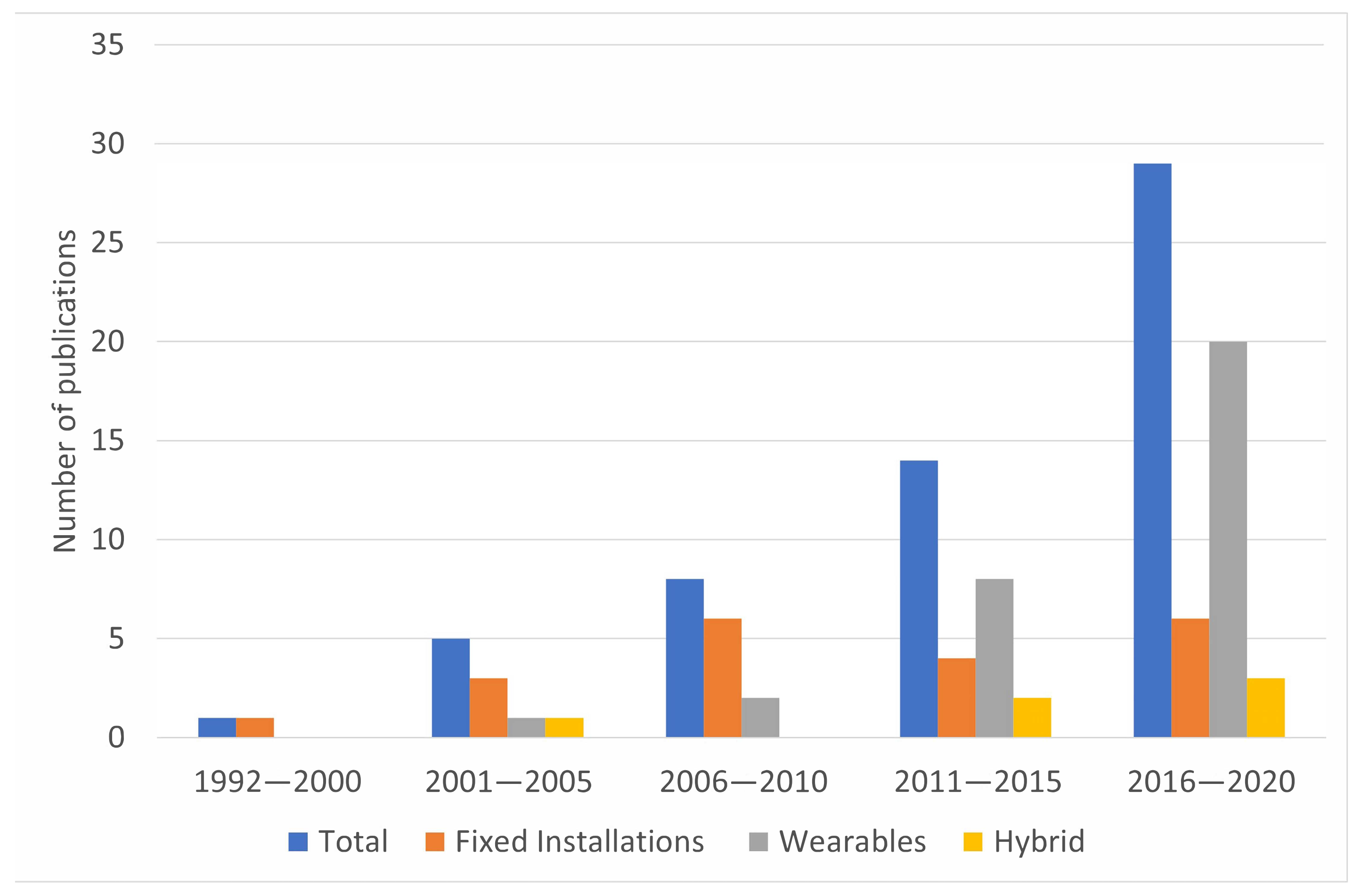
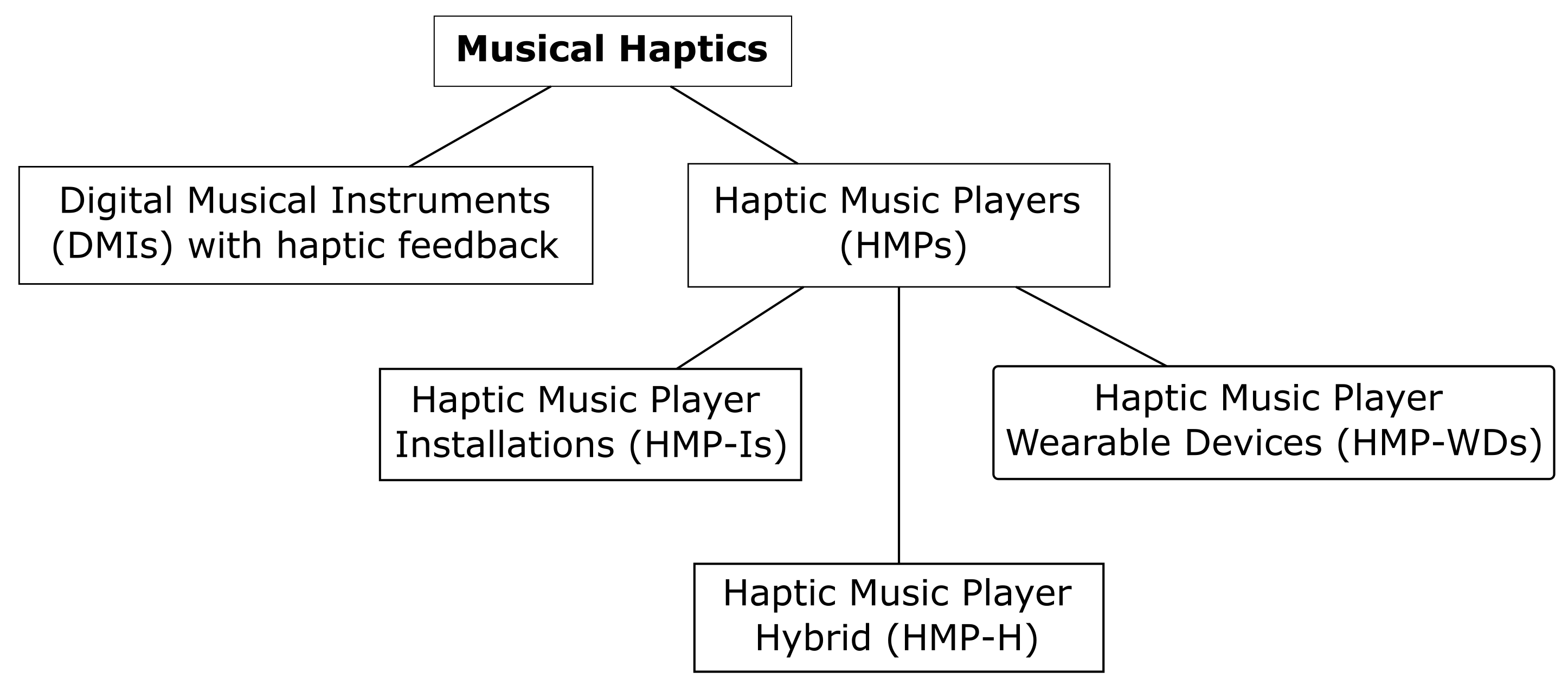
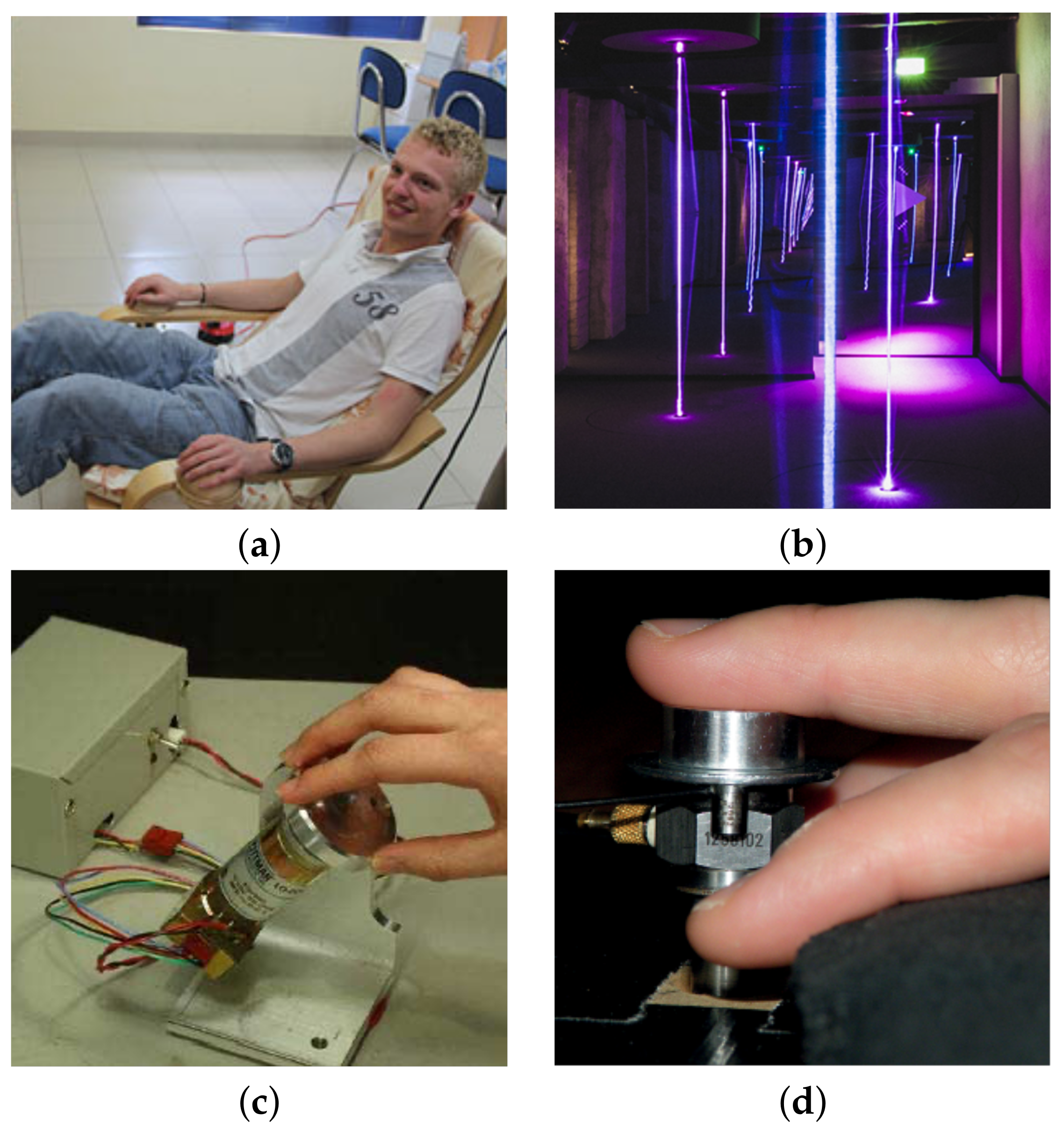
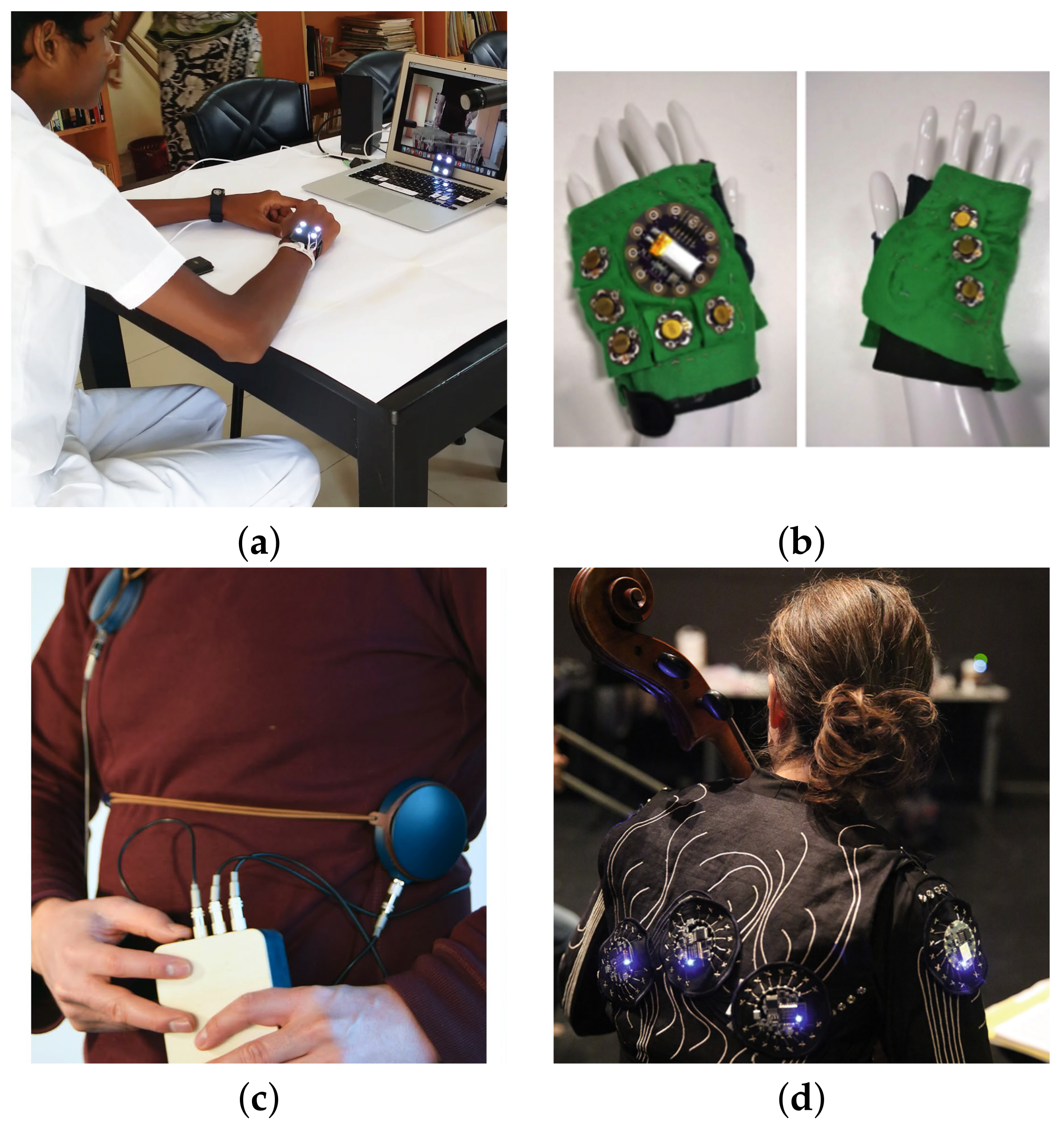
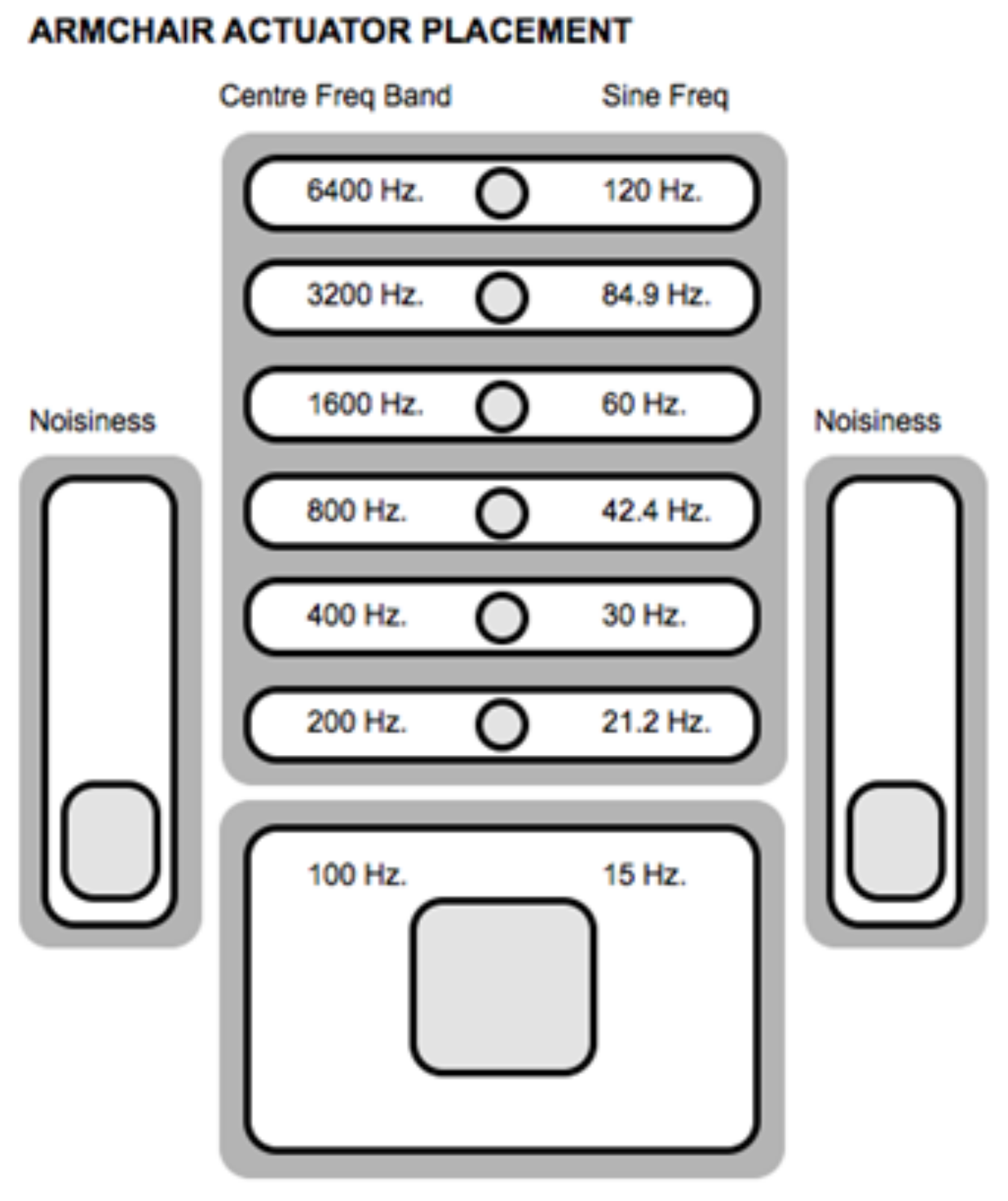
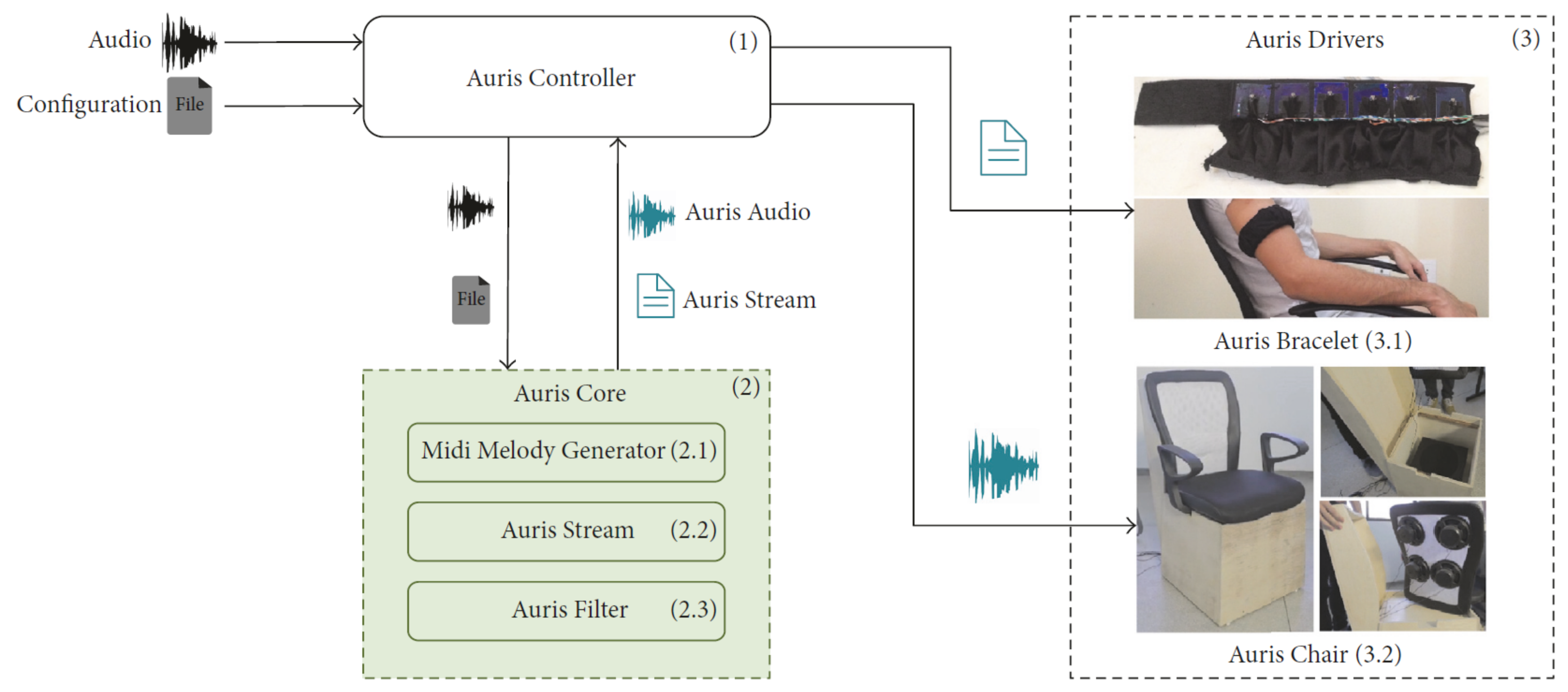
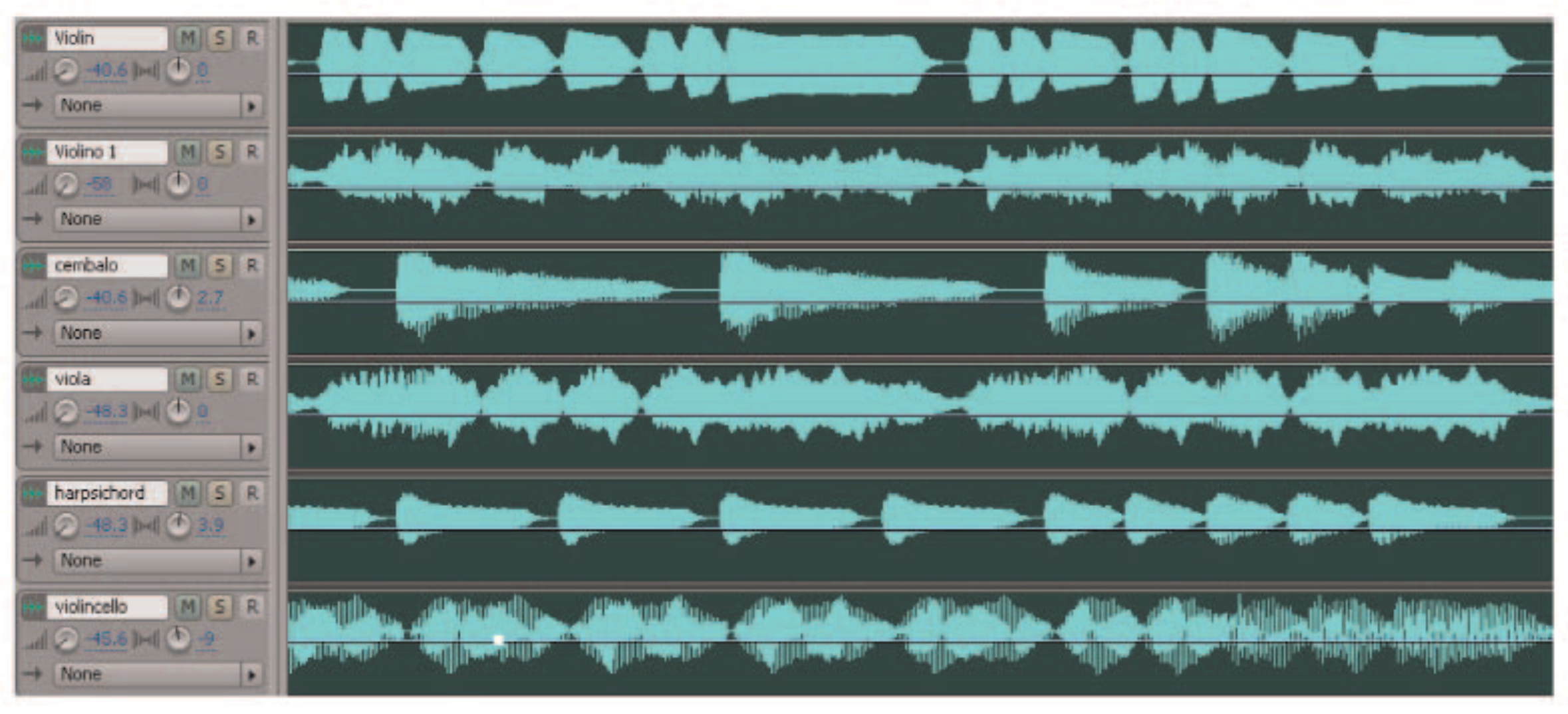
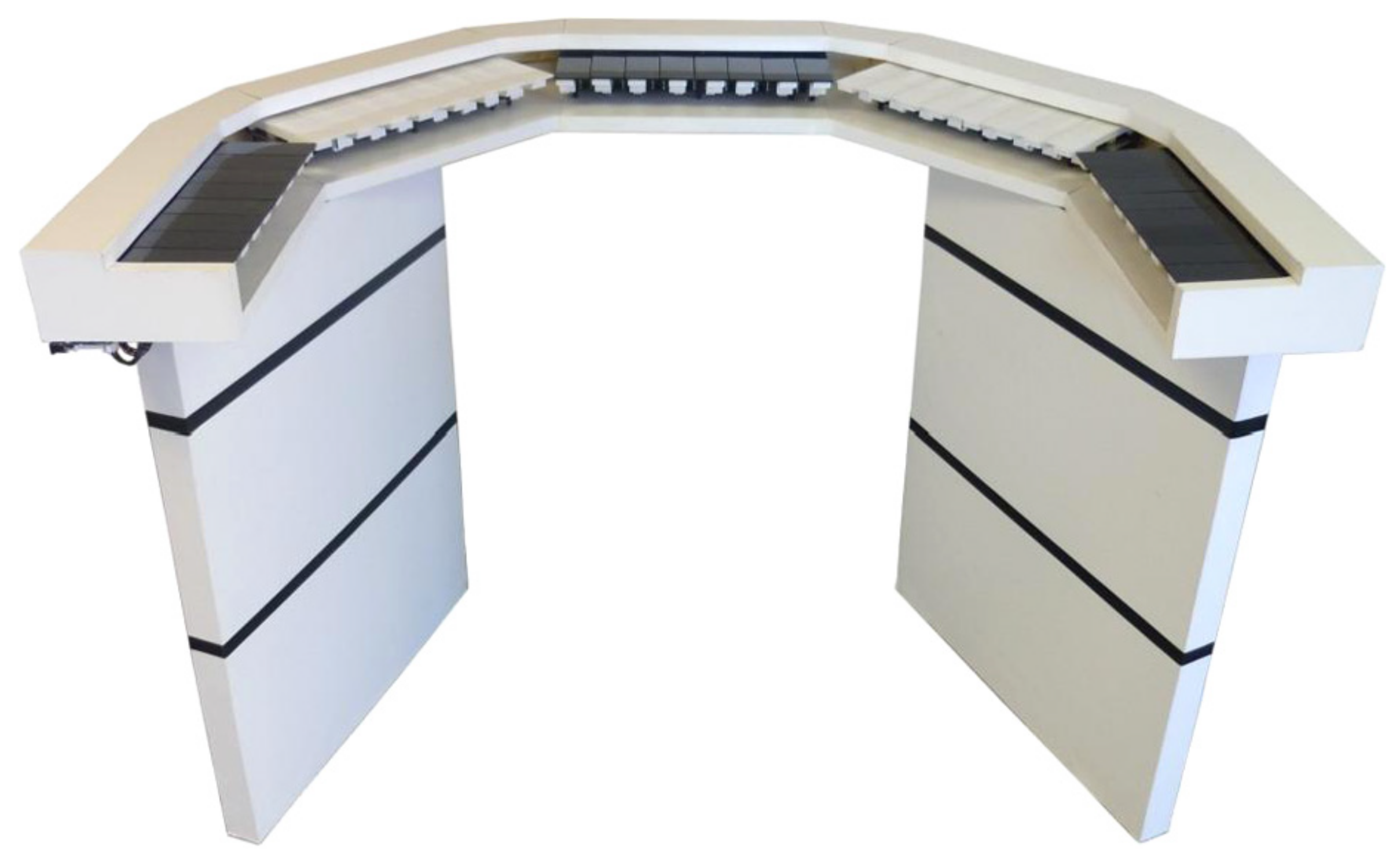
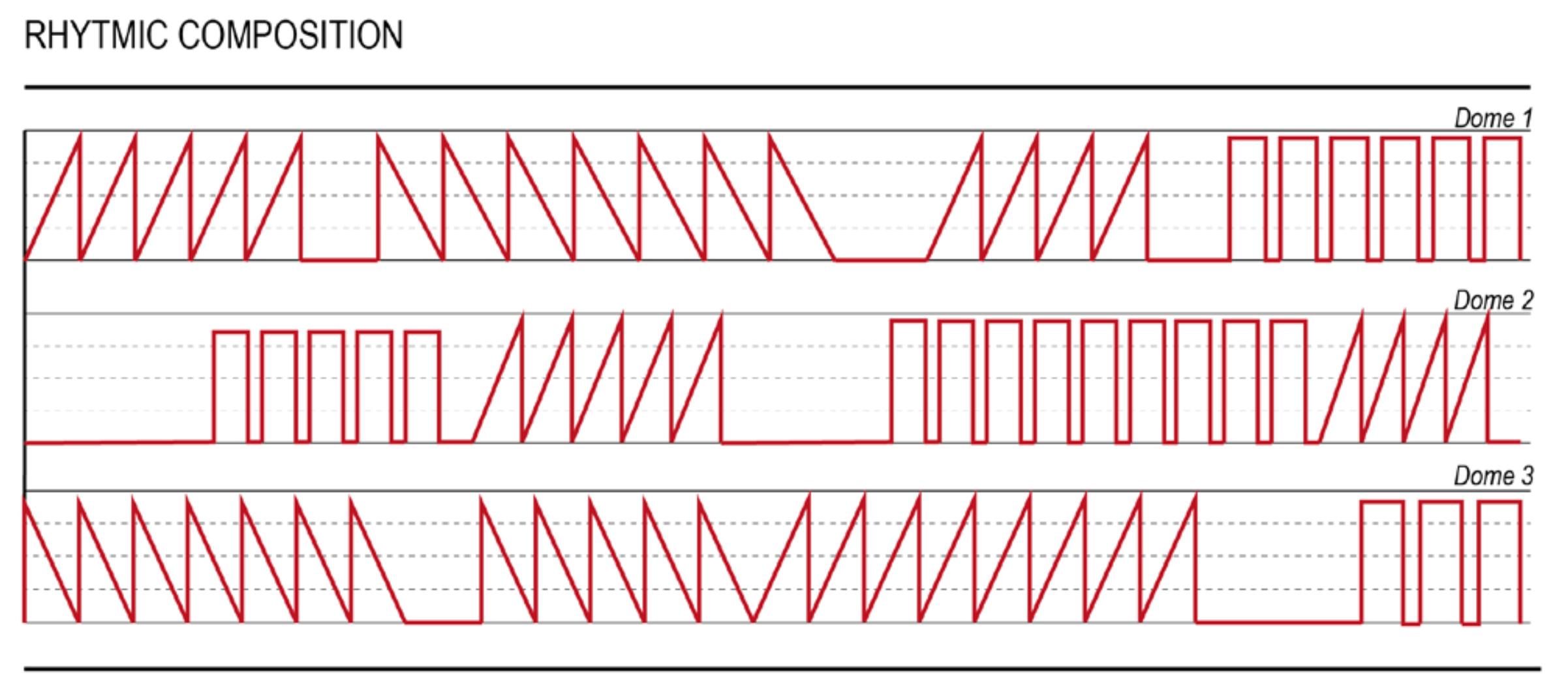
| Psychophysical Channel | P | NP-I | NP-II | NP-III |
|---|---|---|---|---|
| Full name | Pacinian | Non-Pacinian I | Non-Pacinian II | Non-Pacinian III |
| Psychological type | FAF-II | FAF-I | SA-II | SA-I |
| Fiber innervation density (fingertip, per cm2) | 21 | 140 | 49 | 70 |
| Subjective sensation | “vibration” | “flutter” | unknown | “pressure” |
| Frequency range | 40–500 Hz | 2–40 Hz | 100–500 Hz | 0.4–3 Hz |
| Prime sensitivity range | 250–300 Hz | 25–40 Hz | 150–400 Hz | 0.4–1 Hz |
| Shape of frequency response function | U-shape | Flat | U-shape | Flat |
| HMP-I | Year | Contact Mechanism | Type of Actuator | Stimuli | Features Explored |
|---|---|---|---|---|---|
| SOMATRON [52] | 1992 | Mattress | Speaker, Subwoofer | Vibrotactile, Auditory | Pitch |
| Vibratory Music (Patent) [45] | 2002 | Chair | N/A | N/A | N/A |
| Audiotactile Simultaneity [26] | 2004 | Chair | N/A | Vibrotactile, Auditory | ATFS |
| Symbolic Haptic Rendering [50] | 2005 | Knob | N/A | Vibrotactile | Tempo, energy |
| Model Human Cochlea (Design) [14] | 2009 | Chair | Voice coil | Vibrotactile, Auditory | FM , TM , VMLE |
| Multimodal reproduction [30] | 2009 | Seat | Voice coil | Vibrotactile, Auditory | VMLE, BRTF |
| Music Display and Haptic Chair [31] | 2009 | Chair | Speaker | Vibrotactile, Auditory | VMLE |
| Model Human Cochlea [53] | 2009 | Chair | Voice coil | Vibrotactile, Auditory | FM, TM, VMLE |
| Emoti Chair [54] | 2010 | Chair | Voice coil | Vibrotactile | FM, TM, VMLE |
| Whole Body Vibration [48] | 2010 | Chair | Voice coil | Vibrotactile, Auditory | ATFM , BRTF |
| Auditory-Tactile Music [29] | 2013 | Chair | Voice coil | Vibrotactile, Auditory, Visual | BRTF, VMLE |
| Haptic Display [55] | 2013 | Chair | Speaker | Vibrotactile, Auditory, Visual | VMLE, |
| Tactile Musical Device [32] | 2015 | Chair | Voice coil, Subwoofer | Vibrotactile | Loudness, Pitch, Rhythm, Timbre, VMLE |
| Skin Music [33] | 2015 | Chair | Voice coil | Vibrotactile, Auditory | VMLE |
| Musical Notes to the Skin [51] | 2016 | Button, platform | Voice Coil | Vibrotactile, Auditory, Visual | Pitch |
| Feeling the Beat [47] | 2017 | Platform | Voice coil | Vibrotactile, Auditory | Rhythm, Tempo, Beat Synchronization |
| Auditory-Tactile Experience of Music [25] | 2018 | Chair | Voice coil | Vibrotactile, Auditory | ATFS, BRTF, VMLE |
| Music with Vibrations [56] | 2019 | Chair | Voice coil | Vibrotactile, Auditory | F-EQ , VMLE, |
| Vibrotactile Consonance [57] | 2019 | Chair | Voice coil | Vibrotactile | MC |
| Haptic Music [49] | 2020 | Platform | Voice coil | Vibrotactile, Auditory, Visual | BRTF, Frequency, VMC , VMLE |
| HMP-WD | Year | Contact Mechanism | Type of Actuator | Stimuli | Features Explored |
|---|---|---|---|---|---|
| Cutaneous Grooves [15] | 2003 | Whole body suit | Voice coil, Subwoofer | Vibrotactile, Auditory | VMC |
| Model Human Cochlea [28] | 2008 | Belt | Speaker | Vibrotactile, Auditory | FM, TM, VMLE |
| Vibrotactile display [41] | 2010 | Belt | Speaker | Vibrotactile | FD |
| Vibrotactile Music System (Design) [66] | 2011 | N/A | N/A | N/A | VMLE |
| Vibrotactile Music System [66] | 2012 | Not available | Not available | Not available | FD, Interval Size, Pitch Direction |
| Dual Band HMP [37] | 2013 | Mobile device mock-up | DMA | Vibrotactile, Auditory | F-EQ, Rhythm |
| MUVIB [59] | 2014 | Bracelet | Voice coil | Vibrotactile, Auditory | Intensity |
| Vibrotactile Chords [64] | 2014 | Mobile device mockup | Voice coil | Vibrotactile | MC |
| Vibrotactile Composition [67] | 2015 | Jacket, leggins | ERM | Vibrotactile | VMC |
| CollarBeat [46] | 2015 | Collar, belt | Voice coil | Vibrotactile, Auditory | VMLE |
| Audio-Tactile Conversion [63] | 2015 | Mobile device mock-up | Voice coil | Vibrotactile, Auditory | FD |
| Vibroacoustic Device for Music [34] | 2016 | Belt | Motor-String, voice coil | Vibrotactile, Auditory | Amplitude, Frequency, Rhythm, VMLE, |
| MuSS-Bits [18] | 2016 | Bracelet, magnetic, belt | ERM | Vibrotactile, Visual | Rhythm, VMLE |
| Mood Glove [61] | 2016 | Glove | Voice Coil | Vibrotactile, Auditory, Visual | Rhythm, VMLE |
| Feeling Music [60] | 2017 | Bracelet | Voice coil | Vibrotactile, Visual | Rhythm |
| Hedonic Haptic Player: Design [68] | 2017 | Belt | Voice coil | Vibrotactile | VMC |
| Hedonic Haptic Player [35] | 2017 | Belt | Voice coil | Vibrotactile | Rhythm, VMC, VMLE |
| Hapbeat Test [42] | 2017 | Belt | Motor-String, voice coil | Vibrotactile, Auditory | Amplitude, Frequency, VMLE |
| Haptic Melodic Interval [69] | 2018 | Belt, mobile device mockup | Vibrotactile | Melodic interval | |
| Hapbeat Re-Design [70] | 2018 | Belt | Motor-String | Vibrotactile | N/A |
| Music Sensory Substitution System [19] | 2018 | Bracelet | ERM | Vibrotactile, Visual | Rhythm |
| Musical Scale Through Haptic Actuator [62] | 2018 | Mobile device mock-up, VMID | Voice coil | Vibrotactile, Visual | Melody, Pitch, Timming, VME |
| Musical Haptic Wearables [58] | 2018 | Belt (armband) | N/A | Vibrotactile, Auditory, Visual | API , VMLE |
| LIVEJACKET [38] | 2018 | Jacket | Piezoelectric, Subwoofer | Vibrotactile, Auditory | TM, VMLE |
| Musical Haptic Sleeve [39] | 2019 | Sleeve | Speaker | Vibrotactile, Auditory | VMLE |
| Body:Suit:Score [65] | 2019 | Whole body suit | ERM | Vibrotactile, Auditory | Pitch, FM, Tempo, VME |
| Tactile Identification in Music [71] | 2019 | Glove | Voice coil | Vibrotactile, Auditory | VMLE |
| Tactile Musical Emotion [72] | 2020 | Glove | Voice coil | Vibrotactile | Timbre, VMLE |
| Touching the audience [21] | 2020 | Bracelet, jacket | ERM | Vibrotactile, Auditory, Visual | API, VMLE |
| Vibrotactile Captioning [73] | 2020 | Glove | Voice coil | Vibrotactile, Auditory, Visual | EEG , Tempo, VMLE, |
| SENSE [74] | 2020 | Glove | Voice coil | Vibrotactile, Visual | VMLE |
| HMP-H) | Year | Contact Mechanism | Type of Actuator | Stimuli | Features Explored |
|---|---|---|---|---|---|
| Skinscape [27] | 2001 | Chair, bracelet | Voice coil, Subwoofer | Vibrotactile, Auditory | VMC |
| Vibrochord Vs. Piano [66] | 2014 | VMID + Chair | N/A | Vibrotactile | VMC, VME, VMLE |
| Vibrochord Design [76] | 2014 | Vibrotactile music input device + Chair | N/A | Vibrotactile | VMC, VME, VMLE |
| Concert for the Deaf [75] | 2016 | Platform, Jacket | Speaker | Vibrotactile, Visual | VMLE |
| Auris System [40] | 2017 | Chair, bracelet | Voice coil, Speaker | Vibrotactile | Frequency mapping, Rhythm, VMLE, EEG |
| Scaffolding the Music [8] | 2018 | Chair, belt | Chair with voice coil, Belt with ERM | Vibrotactile, Visual | Pitch, Frequency, Rhythm, VMLE |
Publisher’s Note: MDPI stays neutral with regard to jurisdictional claims in published maps and institutional affiliations. |
© 2021 by the authors. Licensee MDPI, Basel, Switzerland. This article is an open access article distributed under the terms and conditions of the Creative Commons Attribution (CC BY) license (https://creativecommons.org/licenses/by/4.0/).
Share and Cite
Remache-Vinueza, B.; Trujillo-León, A.; Zapata, M.; Sarmiento-Ortiz, F.; Vidal-Verdú, F. Audio-Tactile Rendering: A Review on Technology and Methods to Convey Musical Information through the Sense of Touch. Sensors 2021, 21, 6575. https://doi.org/10.3390/s21196575
Remache-Vinueza B, Trujillo-León A, Zapata M, Sarmiento-Ortiz F, Vidal-Verdú F. Audio-Tactile Rendering: A Review on Technology and Methods to Convey Musical Information through the Sense of Touch. Sensors. 2021; 21(19):6575. https://doi.org/10.3390/s21196575
Chicago/Turabian StyleRemache-Vinueza, Byron, Andrés Trujillo-León, Mireya Zapata, Fabián Sarmiento-Ortiz, and Fernando Vidal-Verdú. 2021. "Audio-Tactile Rendering: A Review on Technology and Methods to Convey Musical Information through the Sense of Touch" Sensors 21, no. 19: 6575. https://doi.org/10.3390/s21196575
APA StyleRemache-Vinueza, B., Trujillo-León, A., Zapata, M., Sarmiento-Ortiz, F., & Vidal-Verdú, F. (2021). Audio-Tactile Rendering: A Review on Technology and Methods to Convey Musical Information through the Sense of Touch. Sensors, 21(19), 6575. https://doi.org/10.3390/s21196575








